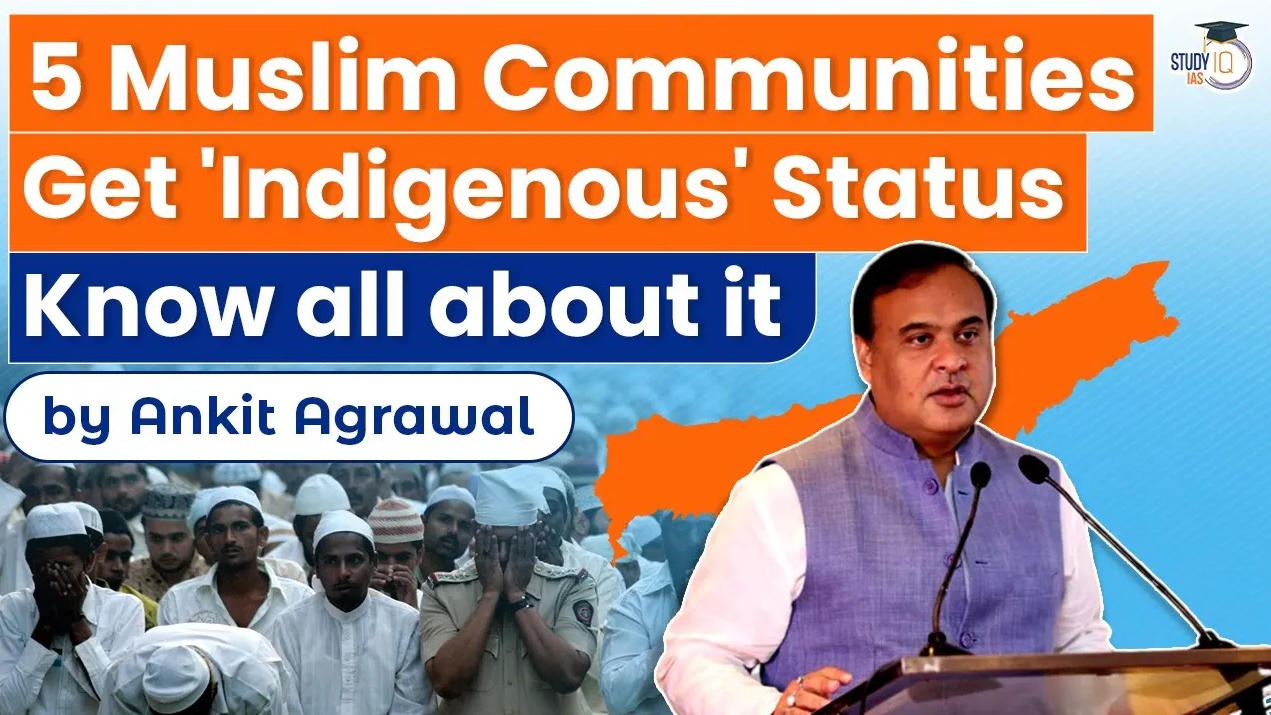Table of Contents
What has happened?
- The Assam Cabinet Tuesday approved the identification of five Assamese Muslim sub-groups — Goriyas, Moriyas, Julhas, Deshis, and Syeds — as “indigenous” Assamese Muslim communities.
- A note from the cabinet said that the move will “ensure their development in health, cultural identity, education, financial inclusion, skill development and women empowerment.”
- The move came days after the BJP-led government decided to offer identity cards to six religious minority communities, Muslims (except the indigenous Muslims), Christians, Buddhists, Jains, Sikhs and Parsis.
- The government said the identity cards would be given for their “identification” and to allow them to get benefits under the schemes meant for the welfare of the minorities.
But why?
- The decision came following the recommendations of a panel constituted by the Assam government last year to discuss socio-economic issues concerning the Assamese Muslim community of the state.
- The panel was set up in July last year after Chief Minister Himanta Biswa Sarma’s meeting with Assamese Muslims from various fields — writers, doctors, cultural workers, lecturers, historians,
- and musicians, among others — To discuss socio-economic challenges faced by the community.
- The stated aim of Sarma’s outreach was the community’s welfare.
- In the meeting, he emphasised that the “uniqueness of the indigenous Assamese Muslims should be protected and preserved”.
Proposal since 2020
- The move first made news when the Assam Minorities Development Board had proposed a “census” for Assamese Muslims in February 2020.
- After a meeting with the community’s members, then state minorities minister Ranjit Dutta confirmed plans to hold the census based on the 2019 Budget,
- That had provisions for a “Development Corporation for Indigenous Muslims” for “holistic development” of the community as well as a “socio-economic census”.
- However, it did not take off. In July 2021, Sarma met with the community leaders, and they were divided into seven sub-committees.
- After months of discussion, their reports were submitted earlier in April this year.
- One of the recommendations said that a notification should be passed to identify “Assamese Muslims” as a distinct group in the state.
- The other suggestions include issuing identity cards or certifications as well as conducting a census to “identify and document” the Assamese Muslim community.
- Back then, Sarma had accepted the report and said they were “implementable”, but in a phase-wise manner.
- “We can categorise them into short term, medium-term and long term,” he had said.
How they are different?
- Considered distinct from Bengali-speaking Muslims, who have a history of migration from present-day Bangladesh (then East Pakistan) to Assam over centuries,
- This group has often expressed the need for a separate identity.
Indigenous Muslim community in Assam
- Under the umbrella of the indigenous Assamese Muslim community fall three main groups: the Goriyas, the Moriyas (from Upper Assam), and the Deshis (from Lower Assam).
- While the Deshis are 13th-century converts from indigenous communities such as Koch Rajbongshi and Mech,
- The Goriyas and Moriyas trace their lineage to converts as well as soldiers, artisans, etc. who came to the region during the Ahom rule.
- Smaller groups such as Julha Muslims also fall under this
- According to organisations representing the Assamese Muslims, of the 1.18 crore Muslim population in Assam,
- Nearly 42 lakh belong to indigenous Assamese communities such as Goria, Moria, Ujani, Deshi, Jola and Poimal.
- They had either converted to Islam or were war prisoners in the Mughal-Ahom battles in Assam in the 13th Century.
Further actions
- The Assam government may undertake a census to identify and document the Assamese Muslim community.
- In regard to political representation, it is suggested that a provision similar to Article 333 of the Indian Constitution might be enacted,
- To provide representation of Assamese Muslims in Parliament and Assam Legislative Assembly.
Indigenous people rights
- India is home to about 700 tribal groups with a population of 104 million, as per 2011 census.
- These indigenous people constitute the second largest tribal population in the world after Africa.
- As industries encroached upon their lands, many communities were displaced and some continued to wage a struggle to either protect their homes or demand a fair compensation.
conclusion
- The move, h kowever, is seen by Bengali-speaking Muslims as a step to create a division among Muslims in Assam and further “alienate” them.
- As its poll plank, the BJP has been targeting Bengali-speaking Muslims in the state, calling them “Bangladeshis”.
Q) Which of the following statements are correct regarding Article 26?
- It deals with rights of individuals.
- Such rights are subject to public order, morality & health.
- 1 only
- 2 only
- Both 1 & 2
- None of the above
Latest Burning Issues | Free PDF
























 WhatsApp
WhatsApp